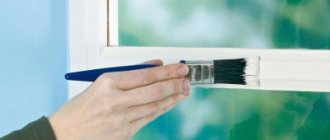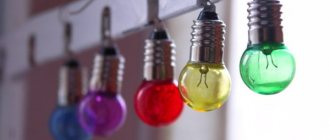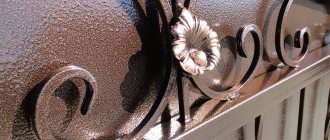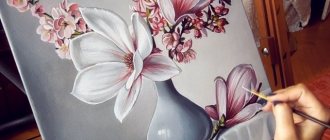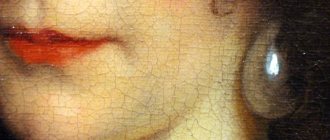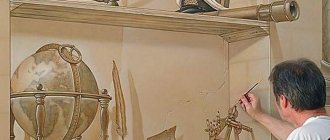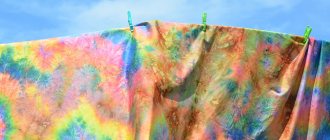Painting a glass surface can give a new look to the material and help change the interior of your home; you can paint a variety of glass, but you need to understand that the process is not as easy as when working with other substrates. This is explained by the smoothness of the surface, which is difficult for paint and varnish products to adhere to. How to paint glass correctly will be discussed in more detail below.
What glass products can be painted?
Painting glass can be used in different situations. Designers like to use such options, but you can apply the technique yourself, and then you will be able to create a unique product. Options when glass painting may be relevant:
- By adding to the overall interior, you can get a unified design style;
- When you need to quickly finish doors between rooms or entrances;
- Painting glass structures to make them look better and more attractive;
- Painted glass can complement cabinets, tables and other furniture items, and is suitable for working with mirrors;
- It is used to create accessories from this material; in this case, the process involves small work that requires special precision.
Painting glass can be used in different situations.
Prices for painted glass
It is important to take into account a set of parameters that determine the cost of painted glass: the price depends on the size and type of material, the complexity of the pattern or the full coloring technology. The price is set per m2.
| Thickness | Price |
| thickness 4 mm | from 1000 rub/m2 |
| thickness 5 mm | from 1100 rub/m2 |
| thickness 6 mm | from 1200 rub/m2 |
| thickness 8 mm | from 1800 rub/m2 |
| thickness 10 mm | from 2000 rub/m2 |
| thickness 12 mm | from 2100 rub/m2 |
Properties of painted glass
Painting the glass surface can be used for decorative purposes or for additional protection of the material. The paint gives a beautiful design to the material, highlighting the base, giving it a better look.
Dark shades can dim the lighting and reduce the amount of light entering through windows. In terms of protection, the fire-resistant property can be increased if glass is painted in the oven.
Painting the glass surface can be used for decorative purposes or for additional protection of the material.
What paints are suitable for working with glass?
The decision on how to paint the glass so that the paint does not wash off must be made after studying the types available for sale. At home, you can choose the following types of paints for this work: acrylic, polyurethane, silicate, and certain types in the form of felt-tip pens, etc. Each has its own excellent characteristics, and you should definitely take them into account when choosing.
Each paint has its own excellent characteristics, and you should definitely take them into account when choosing.
Acrylic paints for glass surfaces
Acrylic paints can be used for painting on glass. They are distinguished by a high degree of adhesion; when the drying stage is completed, a film-like coating remains on the material; they are well suited for smooth surfaces. The layer will be opaque.
Acrylic paints have a high degree of adhesion.
Silicate based paints
Paints with a silicate base. In this case, the composition itself contains elements of glass that is supposed to be painted. After complete drying, liquid glass creates a new glass coating. Similar dyes are produced in different shades, you can choose the right option for yourself.
Now it is possible to use pigments to obtain the desired color; multi-colored options are used. They withstand exposure to ultraviolet radiation and last for many years without changing their properties.
In addition, it is considered a heat-resistant paint for glass; this requires high-temperature exposure, which makes it difficult for household use. Usually chosen by professional craftsmen, in the industrial sector, where suitable equipment is available.
After complete drying, liquid glass creates a new glass coating.
Special stained glass paints
As the name suggests, they are necessary for creating stained glass windows. They help create subtle elements on the surface that are combined into a single composition.
Sometimes you can find information online about the possibility of applying alkyd-based paint to the base, but this paint and varnish material does not adhere well to glass and has low adhesion. There is also a rapid loss of brightness.
Stained glass paints help create subtle elements on the surface that are combined into a single composition.
Fast drying polyurethane dyes
Enamel with a polyurethane base is quick-drying; after drying, a film coating is formed. They are distinguished by a high level of water resistance; when used, it is possible to mix different shades to obtain the desired color. There is also a clear type of polyurethane paint that requires the addition of dye to create the desired tone for painting.
The surface will remain transparent, but the desired shade will be obtained.
Paints can be aerosol. It is more convenient to distribute the composition over the surface using an aerosol if painting will not be used, but a simple painting of the base is required.
It is more convenient to distribute the composition over the surface using an aerosol if painting is not used.
Ink, felt-tip pens, markers
When you need to draw small images or carry out complex painting, you can use paints for painting on glass in the form of felt-tip pens or markers. This form allows you to do this conveniently. They are manufactured to work not only with glass surfaces, but also with ceramic bases. They can, if necessary, be removed from the base, for this reason they are often chosen before decorating products for various events.
When you need to draw small images or carry out complex painting, you can use paints for painting on glass in the form of felt-tip pens or markers.
There are also special mascaras. For this purpose, carcasses are created that have a high level of adhesion to a smooth base. They allow you to create clear boundaries of the pattern with your own hands; rapidographs are suitable for glass. They are a container from which the liquid composition comes out in different thicknesses; for a full-fledged design, you will need to use different sized options.
They allow you to create clear boundaries of the pattern with your own hands; rapidographs are suitable for glass.
Making stained glass
Before applying stained glass to glass, it is necessary to properly prepare the product. To do this, you need to thoroughly clean it from dust and small debris, remove stains with alcohol and wipe dry. After this, you need to apply the outline of the desired pattern using a special varnish. It will prevent the colors from spreading and mixing with each other.
The outline must be drawn very carefully. You should avoid gaps between lines. This may further lead to mixing of colors, and after that the drawing will be spoiled.
After complete drying, stained glass paints become glossy and transparent, and when exposed to sunlight, they shimmer, filling the room with a variety of shades. The final stage will be fixing with varnish.
Painted glass will look very impressive for any interior style and room size.
Glass coloring technology
Painting technology, if followed throughout the entire process, will result in a high-quality result that will also last a long time. Coloring is not so complicated, so you can do it at home to transform household items. A preparatory stage must be carried out in order to obtain an even layer, as well as to improve the adhesion of materials, otherwise the paint will flow down the glass.
If you follow the painting technology, you will get a high-quality result that will also last for a long time.
Surface preparation
It is necessary to prepare the base itself. The glass surface is well cleaned, using soap and water to remove all existing dirt. The solution will be washed off one by one, first using warm water, then cold. The order should be exactly like this. Follow the steps below step by step:
- It is necessary to degrease the surface; acetone or another available solvent is suitable for this;
- Stains on glass are wiped with a soft cloth;
- Those areas that do not need to be painted must be protected from paint; masking tape is suitable for this; it can be easily removed from any surface. Removal is carried out only after the paint has completely dried.
The glass surface is well cleaned, using soap and water to remove all existing dirt.
Tools and operating procedure
Rollers and brushes can be used for work, but the best result is obtained when painting with a spray gun or using paints in spray cans. If felt-tip pens are selected, then you do not need to purchase an additional tool.
You will also need a clean rag, degreaser, and dye. After preparation, proceed directly to staining.
The best result is obtained when painting with a spray gun, or using paints in spray cans.
How to consolidate the result
Painting can be done using different methods. There is an option to completely immerse the products in paint; you will need a container of suitable size. This option is suitable for working with small items. Can also be used:
- The roller allows you to quickly process large surfaces;
- Brushes are suitable for small areas and help paint hard-to-reach areas if the glass is textured;
- The sprayer allows you to quickly paint, the layer will be smooth and beautiful.
You can beautifully decorate glasses, vases and other interior items at home by creating drawings on them. The secret to a long-lasting result lies in the subsequent application of a fixative. The choice depends on the chemistry of the composition that was used for coloring, taking into account that such substances can be harmful and not all can be used for food products.
You can beautifully decorate glasses, vases and other interior items at home by creating drawings on them.
Existing options:
- If film inks are selected for painting, the image is drawn on a plastic file for application. When the layer dries, it is removed and you can transfer it to the glass, the design is glued. However, such a pattern cannot be washed, for this reason it will have to be removed each time;
- Stained glass dyes are fixed with a special varnish, which is intended for these products. Apply the product in a thin layer so that it is not noticeable afterward. It is advisable to purchase paint and varnish of the same brand;
- If you need to fix heat-resistant paint, then an oven is suitable. The painted object is placed on the oven rack, and the required degrees are set according to the manufacturer's instructions. After the required time has elapsed, the oven is turned off and the product processed using the heat-resistant method is waited to cool down. In the future it will be possible to apply varnish;
- In the absence of suitable compositions, in some cases you can fix the result with hairspray, clear nail polish, or acrylic nail gel.
Stained glass dyes are fixed with a special varnish, which is intended for these products.
How to paint correctly
To paint and do it correctly, you will need to become familiar with the technology of the process in question. There are no complex elements in it if you follow the recommendations. You will need to prepare the tool involved, work on cleaning the surface in order to begin painting it. This is interesting: stained glass painting.
Surface preparation
The glass must be washed with soapy water and washed off with cold and warm water. First, wash off with warm, cold water (this is important). Degreasing is carried out, for which purified acetone is used, however, other coloring compounds relevant to the process are also suitable. The stains remaining on the surface will be removed with a dry cloth; the edges and individual transitions, they are not painted, can be easily protected with masking tape. When the work is completed, it can be easily removed from the surface, the painted product will still look good.
Clean the glass before painting
Applying paint
Coloring is performed in several ways:
- Dipping - for this you need to completely lower the product into a bath of coloring material and carefully and delicately remove it. Excess composition will drain off, leaving only a thin film of the coloring composition on the surface.
- Roller - among similar options, this is a simple method when the master rolls the paint with a roller several times, which allows you to create a continuous coating.
- With brushes - it is used when the task is to apply relatively small colored spots to the surface and fill limited spaces. Large surfaces are difficult to paint with conventional brushes, as local unpainted areas may appear.
- Spraying - will quickly paint a large panel, for which a standard spray gun is used. The result is formed in a short time; a transparent film is formed on the surface, which can completely change its appearance.
Spray paint application
How to make stained glass on glass at home
Preparation for stained glass technology is standard. The image itself is first applied along the borders with a special varnish; it serves as a barrier against paint spreading. For this reason, when making a detail in the drawing, you should not interrupt the line. After finishing the work, the result is fixed with varnish.
The image itself is first applied along the borders with a special varnish; it serves as a barrier against paint spreading.
The article described how to paint glass correctly so that it acquires a more interesting structure. There are many options for suitable paints on the market; the composition should be chosen taking into account the operating conditions. The painting process is simple, you can do it yourself.
